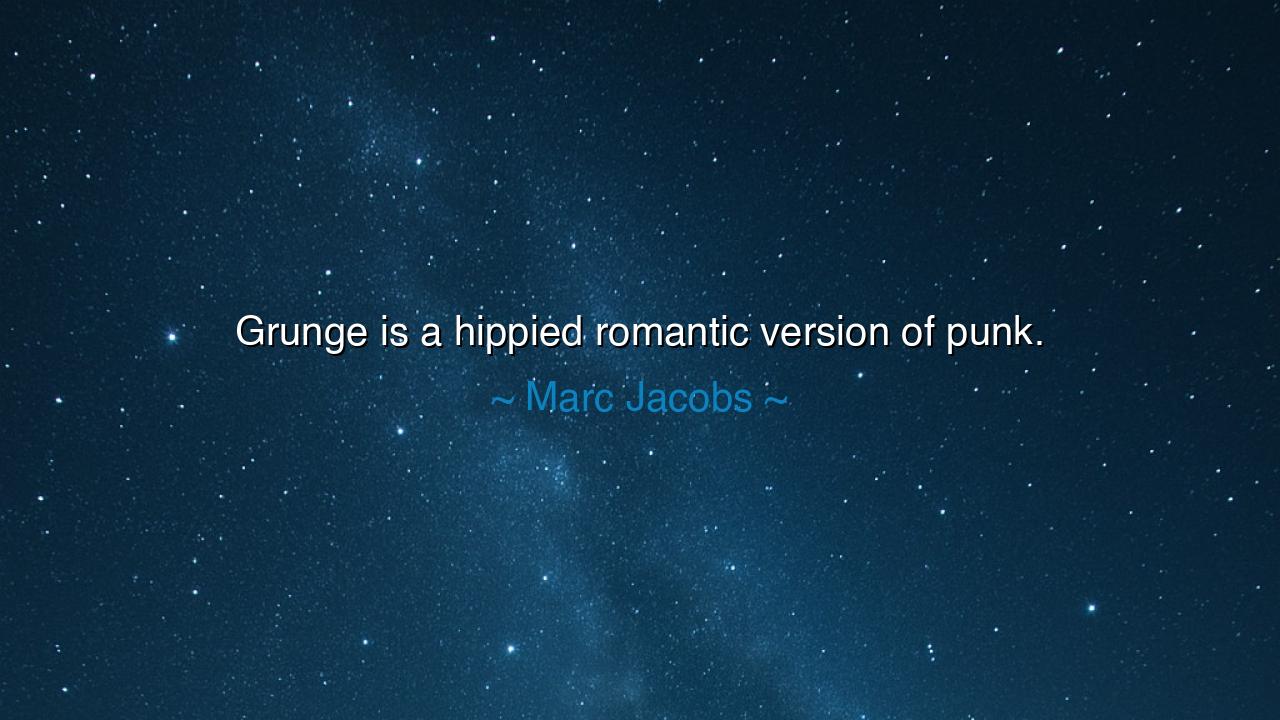
Grunge is a hippied romantic version of punk.






"Grunge is a hippied romantic version of punk." With these words, Marc Jacobs captures a profound reflection on the evolution of subcultures and their transformative power in shaping human expression. He contrasts two distinct yet deeply influential movements in the realm of fashion and music: grunge and punk. At its core, Jacobs draws attention to the romanticism and idealism found in grunge, which, while rooted in the rebellious spirit of punk, carries a softer, more reflective quality. Punk, as the world knew it, was a bold and ferocious cry against societal norms, an unapologetic attack on conventional values. Grunge, however, took the essence of rebellion and infused it with a sense of vulnerability and raw emotion, creating something that was not just angry but also reflective of a deeper sense of searching for identity in a world that felt both alienating and disenfranchising.
In the ancient world, rebellion and romanticism were themes deeply woven into the fabric of society. Consider the tale of Prometheus, the Titan who defied the will of the gods to bring fire to humanity. His act was one of rebellion—a challenge to the established order that empowered humans with the knowledge and tools to forge their own destinies. Yet, within this act of defiance, there was also a deeply romantic aspect, a desire to uplift and enlighten humankind, even at the cost of his own suffering. Much like punk and grunge, Prometheus’ story embodied both rebellion and idealism, a vision of something better beyond the limitations of the present world. Grunge emerged as a new form of rebellion—softened, introspective, but just as powerful in its desire to reshape the world through self-expression and honesty.
Punk, originating in the late 1970s, was an explosive reaction to the stale, corporate-dominated music and fashion world. It was the voice of a generation that wanted to reject convention, to destroy the old ways and build something new and raw. With bands like The Sex Pistols and The Ramones, punk made a raw statement—aggressive, defiant, and loud. The fashion mirrored this, with ripped clothes, spiked hair, and drastic statements meant to shock and disrupt. It was a war cry against conformity, a desire to tear down what was considered normal and replace it with a chaotic expression of individuality. In its early days, punk was a battle—a stark rejection of everything mainstream, often wrapped in a visceral anger and frustration at society’s flaws.
However, as the 1980s bled into the 1990s, grunge emerged from the Pacific Northwest, drawing upon the punk ethos but softening its edges. Bands like Nirvana, Pearl Jam, and Soundgarden introduced a new form of rebellion—one that wasn’t just angry but also deeply melancholic, raw, and introspective. Grunge embraced a romanticism that punk had largely ignored. It was as though the fiery energy of punk was channeled into something more personal, vulnerable, and tinged with a sense of disillusionment. The fashion that accompanied grunge—flannel shirts, ripped jeans, and worn-out boots—was not a statement of outrage but rather a reflective retreat into simplicity. The grunge aesthetic was an outward reflection of an inner world, one that felt both alienated and yearning for something more, a sense of purpose or identity in a world that didn’t seem to care. In this way, grunge became a romantic version of punk, more contemplative and less combative, but still fueled by a desire to break free from the constraints of society.
The lesson here is both profound and relevant to our own lives: rebellion does not have to be expressed only through anger and violence. Sometimes, the most potent forms of resistance come through vulnerability, reflection, and creativity. The grunge movement, much like the rebellion of the ancient figures like Prometheus, was not just about rejecting the old, but about seeking a more authentic expression of the self. Punk was the initial shock, a loud protest against the world, while grunge sought a deeper understanding of the self and the world—a way to challenge convention through self-expression rather than confrontation. Both movements, however, carried the same core truth: freedom is not just about rebellion, but about forging one’s own path and living authentically.
In our own lives, we can learn from these movements. Whether we are standing in rebellion against societal norms, or simply seeking a more genuine way of being, it is important to embrace self-expression in all its forms. Like grunge, we may find that true rebellion comes not from destruction, but from personal reflection and the courage to be vulnerable. Fashion, like all forms of art, can be a tool for expressing both our rebellion and our romantic ideals. We need not conform to a predefined image of how to rebel, nor do we need to engage in rage to communicate our desire for change. Instead, we can find strength in embracing the romantic version of rebellion—one that seeks truth, authenticity, and human connection above all.
Let us, then, seek to understand the full spectrum of rebellion, from the fierce energy of punk to the reflective authenticity of grunge. In our own lives, we can live in harmony with both aspects, rejecting societal constraints while also embracing the beauty of vulnerability, creativity, and self-expression. Whether we express it through fashion, art, or music, may we never forget that true rebellion comes from living in alignment with our most authentic selves—and, in doing so, we offer the world not just a critique, but a more beautiful and meaningful way to be.






AAdministratorAdministrator
Welcome, honored guests. Please leave a comment, we will respond soon